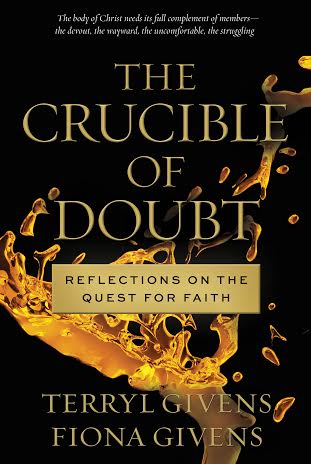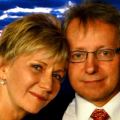The Crucible of Doubt is written by Fiona and Terryl Givens. The inspiration for the book was a series of firesides by Terryl Givens. He read a letter he wrote called “A Letter to a Doubter.”The response to the fireside and letter led to a desire to expand the letter into a book. According to Fiona Givens, “Our hope in writing the book was to give members struggling with challenges to their faith another lens through which they might view their faith. We also hope that those members who are not struggling will gain a greater understanding and empathy for those who are.”
 Although I love the scholarly approach and I found the very eclectic selection of quotes and poems inspiring and thought-provoking, the discussion of lenses and advice was incomplete and awkward at times.
Although I love the scholarly approach and I found the very eclectic selection of quotes and poems inspiring and thought-provoking, the discussion of lenses and advice was incomplete and awkward at times.
The Crucible of Doubt does not focus on specific doubts people may have, but instead focuses on the lens through which we see and develop our faith. How many of our doubts are based on false expectations, cultural traditions, or assumptions?
The book begins with a unique look at logic and invites you to reconsider the value of emotion as a way of knowing and deciding. They suggest that “decisions are best made when emotions are moderated, but not obliterated by reason” (16). Then quoting philosopher Hans Georg Gademer, they note that “bracketing out human meanings from human science means understanding nothing at all” (17). They reframe the fall, the restoration, and our fundamental view of religion, the creation, leaders and scriptures with varying degrees of success.
In all cases they suggest that faith is work and it is up to us as individuals to pray for ourselves, no matter how secure we feel the source is. They quote Henry Eyring: “In this church you don’t have to believe anything that isn’t true.”
I most enjoyed their discussion of religion, while I was both inspired and confused by their treatment of the restoration and church leaders.
About religion they postulate, “Perhaps providing conclusive answers to all our questions is not the point of true religion” (27). This concept was perspective-changing for me. I do feel like we, or perhaps just I, assume our religion should answer all our questions. Religion promises peace and salvation, not answers to everything and definitely not on our time table. Do we assume we should be able to know everything and know it now if we just fast and pray and read our scriptures enough? How fortifying to say with Nephi, “I know that he loveth his children; nevertheless, I do not know the meaning of all things” (1 Nephi 11:17). Allowing ourselves and others to not know is refreshing.
In addition to their concept of the purpose of religion is their conviction of worship and attending church. “Worship,” they identify, “is what we are prepared to relinquish,” not what we are prepared to receive (42). When we attend church it is not a passive experience about who will love us, what knowledge will be poured into us, or what we will receive at all; it’s about what we are willing to give up to know Christ, week by week. We do meet together to unite and learn to love, yet flaws in those around us do not make it impossible for us to learn to love. The Givens invite us to see “the mediocre talk, the overbearing counselor, the lesson read straight from the manual as a lay member’s equivalent of the widow’s mite. A humble offering, perhaps, but one to be measured in terms of the capacity of the giver rather than in the value received” (42). This is an astounding way of viewing our fellow worshippers that would drastically affect our experience at church.
Their treatment of the apostasy and restoration I find lacking. I love their focus on the amazing and inspired men and women who lived during what we normally refer to as the apostasy. However, I found their insistence that Latter-day Saints clearly view the apostasy as a time when the church was hidden and not completely absent as…confusing. Admittedly, I view the Church’s teachings on this matter as unclear. In Gospel Principles it states, “The organization that Jesus Christ had established no longer existed and confusion resulted. More and more error crept into Church doctrine, and soon the dissolution of the Church was complete. The period of time when the true Church no longer existed on earth is called the Great Apostasy.” About the first vision of Joseph Smith, Gospel Principles states “Beginning with this event, there was again direct revelation from the heavens”. Most members of the Church of Jesus Christ will find that right in line with what they have been taught from manuals, sung in hymns and understood about the need for a restoration. Simultaneously, the Church publishes Ensign articles about amazing men and women such as Wycliffe, Luther, Hus or Joan of Arc as inspired. The church is not clear in the differences between revelation and inspiration.
The Givens do not mention any reasons why a member of the church might be confused and just states we shouldn’t be and that we should just celebrate the little lights in the darkness (and we should). There isn’t recognition in The Crucible of Doubt that the mountain of repetition by the church that there was a complete dissolution of the church is contrary to the Givens saying that the church was just in hiding for a period of time. To say revelation was no longer on the earth and needed to be restored while recognizing the inspiration of the great men and women living at that time either requires greater delineation between revelation and inspiration, or perhaps a far greater willingness to embrace the gray area between them. I’m interested in both proposals, but find the absence of the standard church position glaring.
In their treatment of lay leadership in the church they seem to contradict themselves. On one hand they say “Airbrushing our leaders, past or present, is both a wrenching of scriptural record and a form of idolatry. God specifically said that he called weak vessels so we wouldn’t place our faith in their strength and power” (70), which is an intriguing and refreshing concept.
Contrast that to the thought they share later that “God really means it when He delegates His authority to men and women and expects them to use their wisdom and judgment in executing His will…they enjoy God’s sanction for a decision made in error” (76). So God specifically chooses weak vessels, whom we must see clearly, yet they expect God to sanction a leader’s decisions made in error? They repeat that leaders are not always inspired and we have personal responsibility to determine truth and for our own actions, how do you negotiate that in reality? The conflict is problematic and real for members of the church. Untrained, unpaid lay members take roles of tremendous responsibility and can knowingly or unknowingly cause a great deal of pain. Surely their quote does not mean the leader enjoys God’s sanction on something that causes such pain.
Those points aside, I find the Givens’ work thought provoking. I recommend it, though I do so with caveats. If you have doubts, read this book if you are willing to take a fresh look at your doubts. If your doubts are currently eclipsed by the pain you feel in relation to them, I would be careful. My pain in relation to my own doubts seems to ebb and flow and I am at times able to be more thoughtful and open, while at other times I know I’m not able to see clearly. Be gentle with yourself.
If those you love have doubts, this book is not meant to help you fix them. Read it with the intent that your own vision may need correcting and you may learn how to love and understand others more fully, which is what the Givens’ intended.
Even with my previously mentioned issues considered, I can’t resist the vast array of quotes from various faiths and religions and scholarly sources. I allow that the Givens have their own preconceptions and cultural mores. It is valuable to read a book I do not completely agree with and learn from it. Perhaps if we can manage that we will be better prepared to empathize with our friends and family members and learn from them as well.
**I was given a free copy of The Crucible of Doubt in exchange for an honest review.
About Britt Kelly
Britt grew up in a family of six brothers and one sister and gained a bonus sister later. She camped in the High Sierras, canoed down the Colorado, and played volleyball at Brigham Young University. She then served a mission to South Africa.
With all of her time in the gym and the mountains and South Africa, she was totally prepared to become the mother of 2 sons and soon to be 9 daughters. By totally prepared she means willing to love them and muddle through everything else in a partially sleepless state. She is mostly successful at figuring out how to keep the baby clothed, or at least diapered, though her current toddler is challenging this skill.
She feels children naturally love to learn and didn’t want to disrupt childhood curiosity with worksheets and school bells. She loves to play in the dirt, read books, go on adventures, watch her children discover new things, and mentor her children. Her oldest child is currently at a community college and her oldest son is going to high school at a public school. She loves to follow her children in their unique paths and interests.
She loves to write because, unlike the laundry and the dishes, writing stays done. Whenever someone asks her how she does it all she wonders what in the world they think she’s doing.
Twitter •







